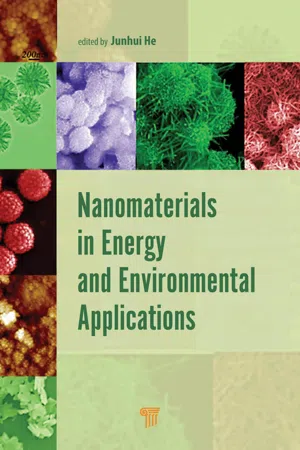
- 548 pages
- English
- ePUB (mobile friendly)
- Available on iOS & Android
Nanomaterials in Energy and Environmental Applications
About This Book
Nanoscience and nanotechnology are interdisciplinary fields that bring together physicists, chemists, materials scientists, and engineers to meet the potential future challenges that humankind will face, including the search for renewable energies for sustainable development and new technologies for carbon capture and environmental protection. Among the current subjects in nanoscience and nanotechnology, nanomaterials are developing fast and explosively and attracting a huge amount of attention. They continue to show promising potential and have found application in solar cells, fuel cells, secondary batteries, supercapacitors, air and water purification, and removal of domestic and outdoor air pollutants. To summarize the past developments and encourage future efforts, this book presents contributions from world-renowned specialists in the fields of nanomaterials, energy, and environmental science. It discusses the design and fabrication of nanostructured materials and their energy and environmental applications.
Frequently asked questions
Information
Chapter 1
Multifunctional Coatings for Solar Energy Applications
1.1 Introduction
1.2 Theoretical Aspects of Antireflection and Self-Cleaning
1.2.1 Principle of Antireflection
1.2.1.1 Basic concept of antireflection

1.2.1.2 Strategies to achieve antireflection
Table of contents
- Cover
- Half Title
- Title Page
- Copyright Page
- Contents
- Preface
- 1. Multifunctional Coatings for Solar Energy Applications
- 2. Functionalization of Polyelectrolyte Multilayers via Counterions
- 3. Glass-Based Proton Exchange Membranes for Fuel Cell Applications
- 4. Silicon Nanowire Arrays: Fabrication, Properties and Energy Applications
- 5. Positron-Positronium Annihilation Studies of Energy- and Environment-Related Nanomaterials
- 6. Graphene: A New Star Nanomaterial in Energy and Environment Applications
- 7. Recent Advances in Synthesis and Applications of Metal-Added Carbon Nanotubes and Graphenes
- 8. Roles of Reduced Graphene Oxide in Improving Photocatalytic Hydrogen Generation Performance over Metal Sulphide Nanocomposites
- 9. Micro/Nanostructured Materials and Their Structurally Enhanced Performances for Environment
- 10. Utilization of Biological Polysaccharides as Eco-Friendly Structural Materials
- 11. Catalysts for Indoor Formaldehyde Control
- 12. Nanostructured Copper Oxide for Sensing Hydrogen Cyanide Gas
- 13. Nanomaterials and Health
- Index